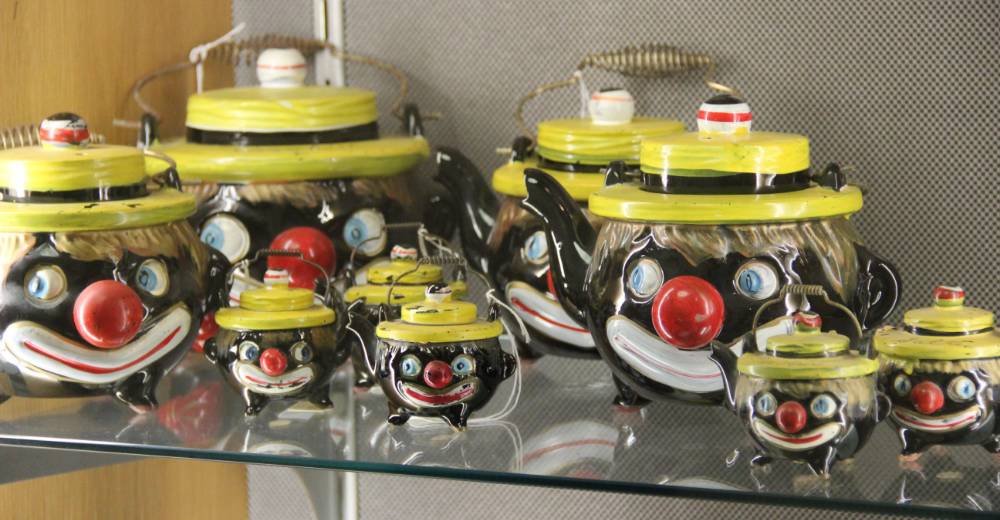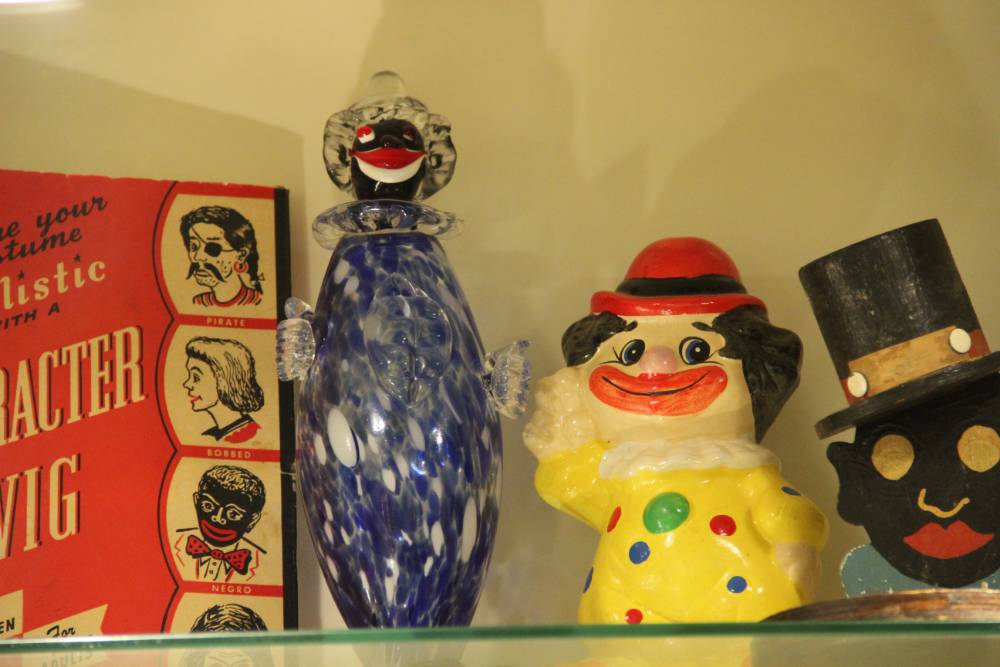Jim Crow Museum
1010 Campus Drive
Big Rapids, MI 49307
[email protected]
(231) 591-5873
Q: I'm writing about the demise of dunk tank clowns and understand they come from a
long tradition of insulting (and worse) attractions from fairs and carnivals.
~J. Nark
 A: Many caricatures of African Americans were designed to be laughed at, reducing black
people to buffoons. In similar ways, these caricatures closely correlate with traditional
portrayals of clowns.
A: Many caricatures of African Americans were designed to be laughed at, reducing black
people to buffoons. In similar ways, these caricatures closely correlate with traditional
portrayals of clowns.
The Jim Crow Museum has a number of teapots, sheet music, and chalk ware objects where the line between clowns and negative black characteristics overlap. In fact, one can look at the make-up and dress of blackface performers and see the striking similarities with clown make-up and dress. Drawn-on, oversized lips, curly unkempt hair, oversized and colorful clothing, white gloves etc… these are staples of anti-black caricatures (on and off minstrel stages) and clowns.
Richard Ward “Dick” Pelham was a well-known blackface minstrel performer and a founder of the Virginia Minstrels. One of the stage characters he played was a “Negro Clown,” which appeared in circuses in the 1840s. He came to fame impersonating a "Negro Clown," who performed a song-and-dance routine in the mold of Thomas Rice's Jim Crow character.
George Nichols, one of earliest blackface performers, is credited as being the first to “combine the character of the clown with Negro song” (Thayer, S., 2005). When Nichols first sang the “Jim Crow” song, he did it as a clown, but afterward, he would perform the song, and act, in blackface (Bean, Hatch, McNamara, 1996).
The movie Monsieur Chocolat chronicles the relationship between Rafael Padilla, an Afro Cuban performer, and
his white partner George Foottit, as they performed a clown duo act that played on
the racial stereotypes of black people around the turn of the 20th century. The line between clowns and blacks were intentionally skewed as Foottit,
the white man, dressed in make-up as a clown and Padilla did not.
The Jim Crow Museum collection also includes scripts of blackface minstrel shows that
were converted to clown acts when minstrel shows lost their mainstream popularity.
The scripts are mostly the same, just some of the derogatory language changed and
the performers used white and red clown make-up instead.
Nevertheless, in regard to the correlation between the African Dip game and clown dunk tanks, there is no clear line as to when a transition happened. However, many clown dunk tank acts gave credit to the African Dip as the inspiration for the act.
The Chicago Tribune printed a story on Carnival acts and talked about a Bozo the Clown that was one of the clowns in a dunk tank game. According to the story, the game was reputed to have evolved from the 1899 African Dip game which had the slogan of “Hit the trigger, dump the nigger” (Chicago Tribune). It’s hard to say if the game actually originated in 1899 as most reports of the game in newspapers and magazines are found beginning in 1910. The African Dodger game was very popular at carnivals, circuses, and fairs during this period and quite frankly, the possibility of actually hitting an African American with a baseball was perhaps far more intriguing to the white amusement seekers than hitting a target and dunking a person into water. Nevertheless, the idea of throwing objects at African Americans for entertainment lasted for many years and took many forms.
In a 1949 article from The Tipton Daily Tribune in Tipton, Indiana, there is mention of the African Dip performer dressed as a clown. This seems to be a clear case of the morphing of the game with clowns. The picture, although not very clear, appears to be a white person dressed as a clown in the African Dip tank. The article goes on to say:
“A lot of those carnival goers were ‘good shots,’ too, from the looks of the fellow in the African dip, one of the main attractions of affair. Dressed as a clown, he fulfilled his role when a true aiming customer hit the bull’s eye on the arm which sent him into a trough of water” (The Tipton Daily Tribune).
In a 1966 article in the Tampa Tribune, the author explains the workings of African Dip game as “a clown is dunked in a tank of water if the participant accurately throws a ball against a triggering device” (Tampa Tribune).
These are only a few examples of white clowns participating in African Dip type of games; the majority of cases involved an African American sitting on the plank. Places like Riverview Amusement Park in Chicago featured a popular African Dip game that ran from the early 1910s to the mid-1960s with the cages being almost exclusively manned by blacks, not dressed as clowns.
Blackface minstrelsy and clown acts were linked early on; therefore would it really be surprising if dunk tanks (another way of mocking black people) were not also a kind of distant relative (ancestor) to certain clown acts?
Thanks for the question.
~Franklin Hughes
Jim Crow Museum
2019
References
Bean, Annemarie, Hatch, James V., McNamara, Brooks (1996) Inside the Minstrel Mask: Readings in Nineteenth-Century Blackface Minstrels. Wesleyan University Press, New England, Hanover, NH, pg. 44
Circus. Amphitheatre of the Republic, (January 14, 1843. Page 3) New York Daily Herold New York, New York. https://www.newspapers.com/image/466562538/?terms=%22negro%2Bclown%22
Legality of State Fair Midway Games is Argued, (January 25, 1966. Page 2-B) Tampa Tribune Tampa Bay, Florida.
Show biz alfresco, Book World, April 12, 1970. Page 6. Chicago Tribune Chicago, Illinois. https://www.newspapers.com/image/?clipping_id=34886746&fcfToken=eyJhbGciOiJIUzI1NiIsInR5cCI6IkpXVCJ9.eyJmcmVlLXZpZXctaWQiOjM3NzE0MDMyOCwiaWF0IjoxNTY3NzEwMjQxLCJleHAiOjE1Njc3OTY2NDF9.oY4sOjev6y4VTcy_MgCnjBo_DdIz2oa19EM9AWshdGc
Thayer, Stuart, American Circus Anthology, Essays of the Early Years, arranged and edited by William L. Slout, (2005) The Circus Roots of Negro Minstrelsy.
Accessed September 12, 2019, https://classic.circushistory.org/Thayer/Thayer2h.htm
Witches Find Pals at Hallowe’en Carnival, (November 1, 1949. Page 1) The Tipton Daily Tribune Tipton, Indiana.